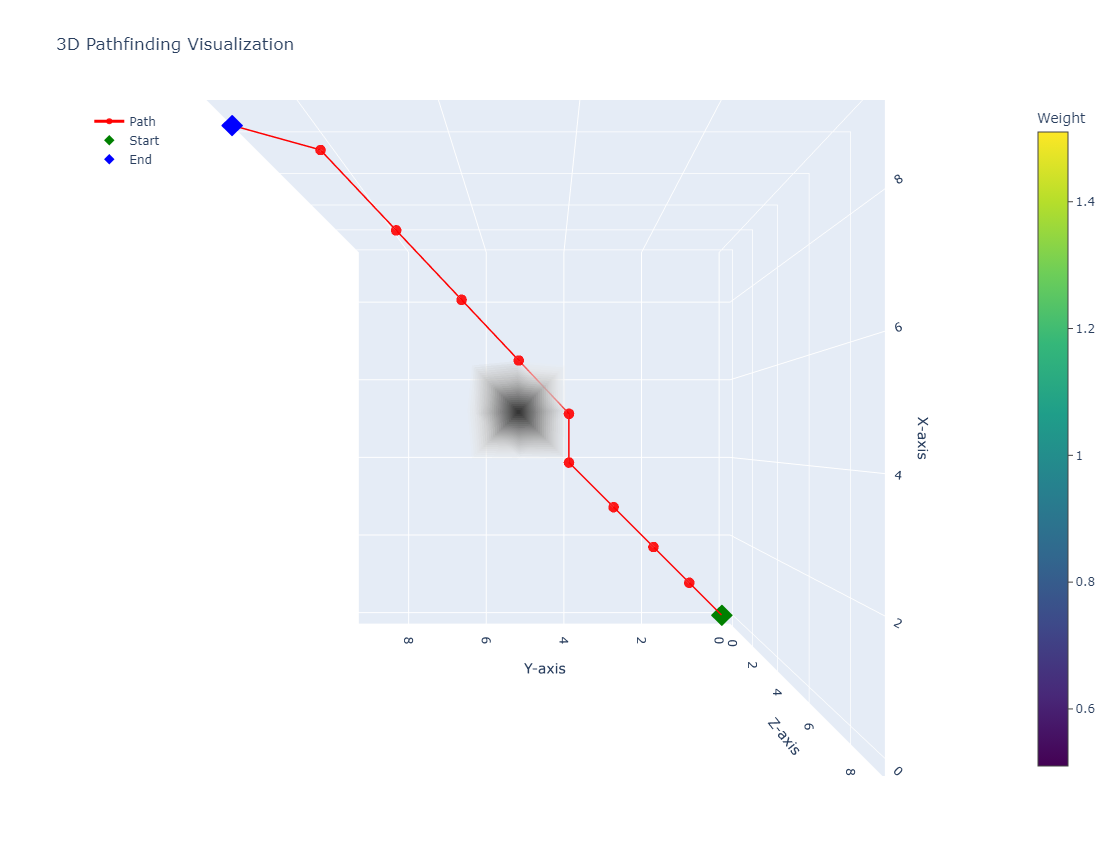
Research
/Security News
Critical Vulnerability in NestJS Devtools: Localhost RCE via Sandbox Escape
A flawed sandbox in @nestjs/devtools-integration lets attackers run code on your machine via CSRF, leading to full Remote Code Execution (RCE).
Pathfinding algorithms in 3D for python3 born from the fork of python-pathfinding by @brean.
Pathfinding3D is a comprehensive library designed for 3D pathfinding applications.
Currently there are 8 path-finders bundled in this library, namely:
Dijkstra, A* and Bi-directional A* take the weight of the fields on the map into account. Theta* is a variant of A* but with any angle of movement allowed.
To install Pathfinding3D, use pip:
pip install pathfinding3d
For more details, see pathfinding3d on pypi
For a quick start, here's a basic example:
import numpy as np
from pathfinding3d.core.diagonal_movement import DiagonalMovement
from pathfinding3d.core.grid import Grid
from pathfinding3d.finder.a_star import AStarFinder
# Create a 3D numpy array with 0s as obstacles and 1s as walkable paths
matrix = np.ones((10, 10, 10), dtype=np.int8)
# mark the center of the grid as an obstacle
matrix[5, 5, 5] = 0
# Create a grid object from the numpy array
grid = Grid(matrix=matrix)
# Mark the start and end points
start = grid.node(0, 0, 0)
end = grid.node(9, 9, 9)
# Create an instance of the A* finder with diagonal movement allowed
finder = AStarFinder(diagonal_movement=DiagonalMovement.always)
path, runs = finder.find_path(start, end, grid)
# Path will be a list with all the waypoints as nodes
# Convert it to a list of coordinate tuples
path = [p.identifier for p in path]
print("operations:", runs, "path length:", len(path))
print("path:", path)
For usage examples with detailed descriptions take a look at the examples folder or at the documentation.
You can visualize the grid along with the path by calling the visualize method of the Grid class. This method can take path as an optional argument and generate a plotly figure. You can install pathfinding3d with the plotly to use this feature with the following command:
pip install pathfinding3d[vis]
The path produced in the previous example can be visualized by adding the following code to the end of the example:
grid.visualize(
path=path, # optionally visualize the path
start=start,
end=end,
visualize_weight=True, # weights above 1 (default) will be visualized
save_html=True, # save visualization to html file
save_to="path_visualization.html", # specify the path to save the html file
always_show=True, # always show the visualization in the browser
)
This will generate a visualization of the grid and the path and save it to the file path_visualization.html and also open it in your default browser.

When rerunning the algorithm, remember to clean the grid first using Grid.cleanup. This will reset the grid to its original state.
grid.cleanup()
Please note that this operation can be time-consuming but is usally faster than creating a new grid object.
All pathfinding algorithms in this library inherit from the Finder class. This class provides common functionality that can be overridden by specific pathfinding algorithm implementations.
General Process:
find_path on one of your finder implementations.init_find instantiates the open_list and resets all values and counters. The open_list is a priority queue that keeps track of nodes to be explored.open_list which contains all nodes to be processed next (e.g. all current neighbors that are walkable). You need to implement check_neighbors in your finder implementation to fill this list.AStarFinder), check_neighbors pops the node with the minimum 'f' value from the open list and marks it as closed. It then either returns the path (if the end node is reached) or continues processing neighbors.check_neighbors calls find_neighbors to get all adjacent walkable nodes. For most algorithms, this calls grid.neighbors.check_neighbors calls process_node on each neighbor. It calculates the cost f for each neighbor node. This involves computing g (the cost from the start node to the current node) and h (the estimated cost from the current node to the end node, calculated by apply_heuristic).process_node updates the open list so find_path with new or updated nodes. This allows find_path to continue the process with the next node in the subsequent iteration.The following diagram illustrates the process:
graph TD;
style find_path stroke:#333,stroke-width:2px
style init_find stroke:#333,stroke-width:2px
style while_open_list_not_empty stroke:#333,stroke-width:2px
style check_neighbors stroke:#333,stroke-width:2px
style pop_node stroke:#333,stroke-width:2px
style find_neighbors stroke:#333,stroke-width:2px
style process_node stroke:#333,stroke-width:2px
style return_empty_list stroke:#333,stroke-width:2px
style return_path stroke:#333,stroke-width:2px
find_path["find_path"] --> init_find["init_find\n(re)set global values\nand open list"];
init_find --> while_open_list_not_empty["while open_list not empty"];
while_open_list_not_empty --> check_neighbors["check_neighbors\n(for node with min 'f' value)"];
check_neighbors --> pop_node["pop_node\n(node with min 'f' value)"];
pop_node --> find_neighbors["find_neighbors\n(get neighbors)"];
find_neighbors --> process_node["process_node\n(calculate new cost)"];
process_node --> while_open_list_not_empty;
while_open_list_not_empty -- "open list empty" --> return_empty_list["return empty list"];
while_open_list_not_empty -- "path found" --> return_path["return path"];
Run the tests locally using pytest. For detailed instructions, see the test folder:
pytest test
We welcome contributions of all sizes and levels! For bug reports and feature requests, please use the issue tracker to submit bug reports and feature requests. Please Follow the guidelines in CONTRIBUTING.md for submitting merge requests.
Pathfinding3D is distributed under the MIT license.
Find a list of contributors here.
FAQs
Pathfinding algorithms in 3D grids (based on python-pathfinding)
We found that pathfinding3d demonstrated a healthy version release cadence and project activity because the last version was released less than a year ago. It has 1 open source maintainer collaborating on the project.
Did you know?

Socket for GitHub automatically highlights issues in each pull request and monitors the health of all your open source dependencies. Discover the contents of your packages and block harmful activity before you install or update your dependencies.

Research
/Security News
A flawed sandbox in @nestjs/devtools-integration lets attackers run code on your machine via CSRF, leading to full Remote Code Execution (RCE).

Product
Customize license detection with Socket’s new license overlays: gain control, reduce noise, and handle edge cases with precision.

Product
Socket now supports Rust and Cargo, offering package search for all users and experimental SBOM generation for enterprise projects.